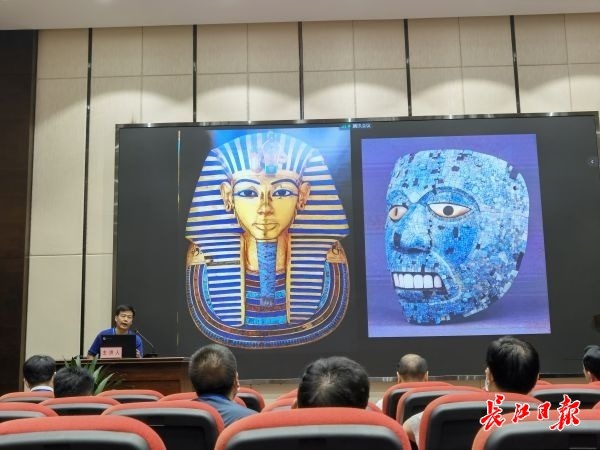Why is the turquoise called the "national jade" of the Xia Dynasty?National cultural blog experts say this
Author:Changjiang Daily Time:2022.06.21
The Yangtze River Daily Da Wuhan Client June 21 (Reporter Feng Aihua) On June 21, the Chinese Emerald Cultural Exchange Conference hosted by the Jade Professional Committee of the Chinese Cultural Relics Society and hosted by the Zhushan County People's Government and the Panlong City Site Museum hold. From the "national jade" of the Xia Dynasty to the tens of billions of industrial goals in Zhushan County, Hubei, the value of turquoise has not been discovered in archeology, but also enlarged and benefited the local area in scientific development and utilization.

Academic exchange scene. Reporter Feng Aihua Photo
Green pine not only has a long history in China, but also has a unique lofty status. The beauty of pine stone is the most primitive value of the natural beauty. At first, people used the natural beauty of the stone to use it as a jewelry or decoration to give it the function of decorative. Because of its rarity, it has enhanced the economic value of turquoise, and gradually becomes assets and wealth in the transaction, which has the function of symbolizing wealth. In addition, it is related to politics, becoming a sign of hierarchy or specific groups, and has the function of political hierarchy. Yang Mingxing, a professor at the Jewelry College of China University of Geosciences, mentioned that looking at the status of turquoise, it not only depends on its "circle of friends", but also who is in the C position. The golden hat of the Xiongnu king, the crown of Kangxi, the green pine is in the most eye -catching and top position. Looking back at the history of nearly 90000, you can see that "the value of turquoise opening is not low". When the culture of Erlitou reached its peak, it became the "national jade".

Academic exchange scene. Reporter Feng Aihua Photo
Zhang Changping, a professor of Wuhan University, who has long carried out archeological research at the Panlong City site for a long time, detailed the decoration stage of the Greenstone in the Neolithic era, the ritual stage of the Xiashang era, the thick decoration stage of the Warring States Period and the Spring and Autumn Period-Ming and Qing Dynasties-Ming and Qing dynasties-Ming and Qing dynasties The characteristics of the four periods of the hardcover stage. For example, during the stringing stage, the processing process of drilling, grinding, etc. reflects the progress of the productivity level at that time, and lays the foundation for the ceremony stage; the bronze medal decoration in the ritual stage two miles uses the embedded process, forming a concentrated blockbuster turquoise Decorative visual effects, highlighting the accumulation of private wealth and complex etiquette, beliefs; the characteristics of the rough decoration stage are the combination of turquoise and bronze, which weakens the etiquette of turquoise at this stage; after the spring and autumn, the combination of turquoise and gold highlights the prominent It is the stage of fine processing.

Academic exchange scene. Reporter Feng Aihua Photo
Why is the turquoise called "national jade"? Zhao Haitao, an associate researcher at the Institute of Cultural Relics and Archeology of the Chinese Academy of Social Sciences and the captain of the Erlitou team, is based on the archeological excavation of Erlou. In 2002, the green pine dragon inlaid inlaid with more than 2,000 pieces of turquoise was unearthed at the Erlitou site, and it was called the real "China's first dragon" by many scholars. Another bronze medal decoration of the beast face is made of hundreds of green pine with only a few millimeters in size. After more than 3,000 years, it has remained motionless and the craftsmanship is superb. The bronze medal of the beast noodles is displayed at the Panlong City Site Museum's "Skythem Biography Qianqiu -Ancient Chinese Gourds Cultural Exhibition". Zhao Haitao believes that the excavation of the unearthed green vessels in the Erlitou site can be regarded as a peak in the history of Chinese turquoise crafts, providing important information for the study of the Xia Dynasty's ritual system and the characteristics of the king's rights.
Archaeologists analyzed the process of Erlitou turquoise artifacts and found that their production process contains systems and combined processing methods of different technologies such as rough mining, cracking, cutting, grinding, perforation, polishing, inlaying, and spelling. Compared with the contemporary craftsmanship, it can be said to be a vein, which fully demonstrates the vitality of the long history and endlessness of the Chinese civilization. It is understood that in Zhushan County, Hubei, which has the reputation of "Hometown of Gourd in China", the green pine resources have preserved 70%of China's and 50%of the world. , Europe, West Asia, East Asia and other countries and regions.
[Edit: Deng La Xiu]
For more exciting content, please download the "Da Wuhan" client in the major application markets.
- END -
[Shuxiang Chongzhou] Read the text together the fifth issue of "One drop of water flows over Lijiang"

A drop of water flows across LijiangAuthor: AlaiRecitation: Liu XinyueI was snowy ...
"Original Poetry" Huang Yue | Fame and outer things behind me, leave half of the poems (seven unique)

Self -topicDo not lower the head of high branches, let the wind frost dye the silk...